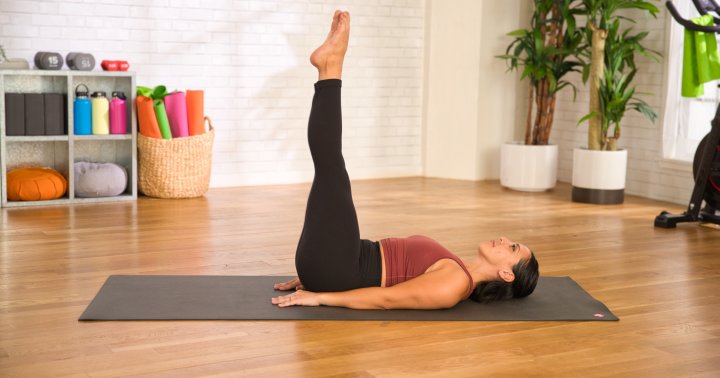Advasana (Reverse Corpse Pose) meaning, steps, precautions and benefits
Advasana widely known as Reverse Corpse Pose in English is a relaxation posture. The Sanskrit name Advasana is derived from two words, the first Adva, meaning Prone and the second Asana, meaning Posture. It is usually practiced as a...


Advasana widely known as Reverse Corpse Pose in English is a relaxation posture. The Sanskrit name Advasana is derived from two words, the first Adva, meaning Prone and the second Asana, meaning Posture. It is usually practiced as a relaxing pose after performing other yoga poses. This asana is extremely beneficial for relaxing and calming the mind and the body, along with it there are many other benefits of Advasana. But it’s quite necessary to first have ample knowledge of the steps to practice an asana. So, let’s begin by knowing the steps to practice Reverse Corpse Pose.
Steps to practice Advasana (Reverse Corpse Pose)
In order to avoid complications or any kind of injury during the practice of an asana and to attain maximum benefits, it is highly crucial to know the right alignment of the body. Following are the steps to practice Advasana correctly:
Lie on the ground, straight on the stomach.Stretch both the arms just straight above the head. Keep both the palms facing downwards and the forehead resting on the ground.Move both the feet somewhat apart so that you may feel comfortable. Keep the eyes closed.Make sure that the head and the spine are in a straight line.Take each breath as slowly and deeply as you possibly can without forcing, concentrate on each inhalation and exhalation.Get completely lost in your breaths.Try to relax each and every part of your body.After resting for a few moments, again become aware of the material world and slowly release the posture.
Lie in this asana for as long as you find it comfortable, but generally, a 2 minutes’ practice is enough. Count each and every breath in order to feel them deeply. This asana is more beneficial when done after practicing other asanas.
Precautions for Advasana (Reverse Corpse Pose)
Following are the precautions necessary to be kept in mind before practicing Advasana for a safer practice:
While lying on the stomach, some people may face slight complications in breathing. So, it is better to place a pillow beneath the chest in order to prevent breathlessness.Avoid moving the body at all while practicing this asana as even the slightest movement may disturb the practice.Avoid practicing this asana in the disturbing atmosphere as disturbances may disturb the peace of mind.Benefits of Advasana (Reverse Corpse Pose)
Following are the health benefits of Advasana which can be experienced gradually with regular practice:
Improves the digestion and stimulates the appetite.Quite helpful for people suffering from slipped disc.Improves the blood circulation in the body.Helpful in getting rid of stooping shoulders.Very beneficial in removing the stiffness of the neck.Removes all kinds of stress, tension and anxiety.Helpful in balancing the functioning of all the abdominal organs.Rejuvenates and refreshes the whole mind and body.Helpful in getting rid of depression, mental anxiety, stress, tension and fatigue.Variations of Advasana
1. Head sideways
Advasana of Head Sideways Yoga is intended to relieve head, spine, and neck injury caused by forward head position. However, it could be beneficial to all yoga pupils. For example, individuals who encounter frequent skull, jaw, and nerve pain may improve from practicing this routine twice or four times each week; individuals who do not suffer severely may gain from practicing it once or twice a month to maintain suffering at a distance.
However, when any of the postures or movements in this series feel particularly beneficial to you, feel inclined to practice them frequently, whether during a pause during your working hours or as part of your weekly yoga practice.
2. Crocodile pose
Crocodile Pose or Makarasana is a great starter yoga posture that loosens the entire body and aids in the alleviation of discomfort caused by other yoga positions or actions. Crocodile pose is an outstanding position between back-firming poses because it calms the entire respiratory system. Its name is derived from the Sanskrit words Makara, which means crocodile, and asana, which means posture.
Resting on your tummy with your chest area supported relieves back and shoulder pressure and exposes your chest and upper arms. This pose is excellent for stress relief. In addition, this yoga posture can be used as a finishing pose at the end of practice or series.
Stay healthy stay strong and get the best out of life.
Like this post? If yes, then don’t forget to share it with your friends on Facebook, Twitter, and Google Plus!
Here are few hand-picked article you should read:
Pawanmuktasana (Wind Relieving Pose) steps, precautions & benefits.Ashwa Sanchalanasana (Equestrian Pose) steps, benefits & precautions.Purvottanasana (Upward Plank Pose) steps, precautions & benefits.Marjariasana (Cat Stretch Pose) steps, precautions & benefits.Please feel free to ask and suggest anything in the comments.
Thanks for reading. Visit again.

 MikeTyes
MikeTyes 





























